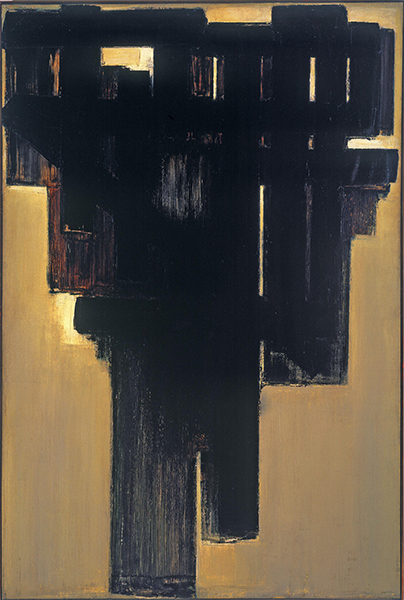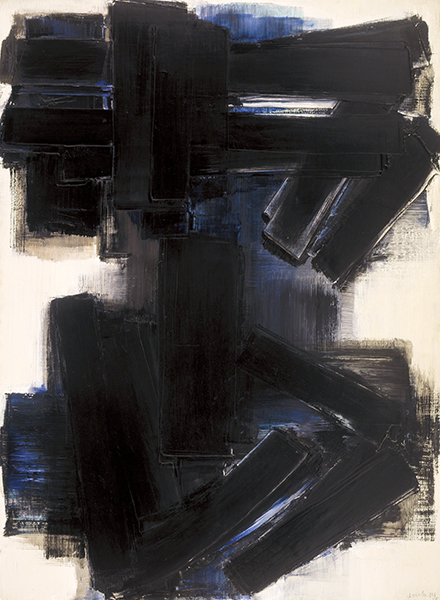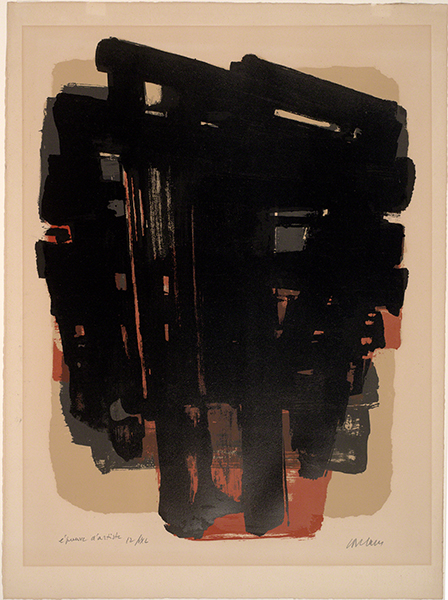April in a New Perspective: Pierre Soulages
I’ve been a big admirer of Pierre Soulages’s work since I saw a show featuring him and Swiss artist Gérard Schneider (1896–1986) when I was home a few years ago. They were both members of a group dubbed l’Art Informel, which literally meant “free art.” The artists were dedicated to free abstraction of all sorts, mostly gestural. It has sometimes been called the European version of Abstract Expressionism, though I don’t think the artists’ egos were as big as their American counterparts—they didn’t have a Clement Greenberg (1909–1994) marketing them.
 |
| Pierre Soulages (1919–2022, France), 3 April 1954, 1954. Oil on canvas, 76 ¾" x 51 ¼" (194.9 x 130.2 cm). Albright-Knox Art Gallery, Buffalo, NY. © 2020 Artists Rights Society (ARS), New York. (AK-190srars) |
This painting, which is a rendition of a rainy April day, coincides with the weather we are now having. Although some may consider black a “somber” color, I have always found it exciting and open to many possibilities, including the idea of revealing other exciting colors emerging from underneath, as we see in Soulages’s work. Please suspend your ideas about the color black as you look at his paintings and prints. Think of how beautiful the work of Abstract Expressionist Franz Kline (1910–1962) is, and how his paintings give peaks of gorgeous color through their grids of black lines!
From the 1940s to the 1970s, Soulages's work was gradually characterized by a surface dominated by black calligraphic brush work. He inflected these works with hints of color, mainly ochre and blue. His work shifted to monochrome (black) around 1979, when he started his series of outrenoir (“beyond black”) works. These works were purely gestural and went beyond the build-up of paint seen in 3 April 1954.
However, works such as this set the aesthetic for Soulages's later works. He systematically applied thick layers of black paint to the canvas, modifying it by scraping and striating it. The surface reflects light in a variety of ways, making black a luminous "color." The artist often preferred to hang his works in the center of the gallery rather on the walls. He was bucking the centuries-old perception of painting as a "window" into another space, claiming that his works were walls, not windows.
In post-World War II (1939–1945) Paris, there was a rise in interest among a group of artists in abstraction that was not dogged by a philosophy or canon, such as the pre-war styles of De Stijl, Cubism, Futurism, Constructivism, and Suprematism, which had dominated European aesthetic through the Bauhaus years. These artists sought pure abstraction that was spontaneous, intuitive, and guided by emotion. It coincided with similar developments at the same time in the United States with Abstract Expressionism.
One French critic gave the movement the name l'Art Informal, and yet another named it Tachisme, related to the word tache, which means "stain” or “drip.” Tachisme referred specifically to the French version of "action painting." Like Abstract Expressionist painters of the same genre, these artists emphasized a lively surface, gestural brush work, and generally automatist creation. The artists of l'Art Informel worked in various types of totally nonobjective abstraction.
As a child, Soulages, born in Rodez, France, was fascinated with pre-historic cave paintings, Celtic sculpture, Romanesque architecture, and the Romanesque sculpture of the Abbey Church of Sainte-Foy in Conques. Studying art in Paris in 1938, he absorbed the work of Picasso (1881–1973), Cézanne (1839–1906), and the older masterworks in the Louvre. After briefly studying at the School of Fine Arts, Soulages quit, rejecting the conservative traditional training. Painting on his own, he began to focus on bare black tree branches against the sky.
Although unable to paint during the war, he was introduced to the geometric abstraction of Sonia Delaunay (1885–1979), whom he met in 1943. Her work was grounded in Cubism and Surrealism. After the war, Soulages began painting in automatism, a method favored by the Surrealists and Abstract Expressionists alike because it relied on intuitive, rather than "rational," creation. He developed his signature style of thick impasto, preferring black as the conveyor of his expression, emphasizing the physicality of the paint.
I find 4 July 1956 (below) particularly beautiful with the cobalt blue shining through the luxurious black. It also puts me in mind of calligraphy, which was one of the influences on Soulages’s technique.
 |
| Pierre Soulages, 4 July 1956, 1956. Oil on canvas, 51" x 38” (129.5 x 96.5). Albright-Knox Art Gallery, Buffalo, NY. © 2020 Artists Rights Society (ARS), New York. (AK-443srars) |
In the medium of color lithography, Soulages brilliantly captured the spontaneity and exciting nature of his brush strokes in oil.
 |
| Pierre Soulages, Brown and Black Composition. Color lithograph onpaper, 30" x 22" (76.2 x 55.9 cm). Albright-Knox Art Gallery, Buffalo, NY. © 2020 Artists Rights Society (ARS), New York. (AK-4319srars) |


Comments